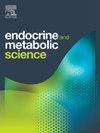Adrenal incidentaloma: Prevalence and evaluation. Experiences from a single health network
Q3 Medicine
引用次数: 0
Abstract
Background
Increasing utilization and sensitivity of radiological imaging has led to an increase in the detection of adrenal incidentalomas (AIs). Most AIs are non-functional benign lesions, though, exclusion of functional and/or malignant AIs is mandatory. International guidelines describe the recommended evaluation of these lesions. However, data on local adherence to such recommendations is unknown.
Aims
To investigate the prevalence and evaluation of AIs discovered in a metropolitan health network and compare the data with established guidelines.
Methods
The study involves a retrospective identification of patients over 18 years old using keyword search criteria within radiology reports from computed tomography (CT) studies performed during 2019 and 2020. Clinical notes and the electronic medical record were interrogated to gather pathology results, co-morbidities, and follow-up. Patients with a known history of active malignancy, suspected adrenal pathology, or an established history of an adrenal adenoma were excluded.
Results
Adrenal incidentalomas were identified in 274 patients, with a prevalence of 0.7 %. Biochemical evaluation occurred in 15.3 % of AIs, and the recommended evaluation of cortisol and catecholamine excess occurred in 8.0 % of cases. Dedicated adrenal imaging occurred in 14.6 % of cases, and 10.2 % of AIs referred to endocrinology. Benign non-functional adenoma was the most common diagnosis; however, most AIs (82.1 %) did not have a final diagnosis.
Conclusions
Our study demonstrates a significant gap between guideline-recommended investigation of AIs and clinical practice. A similar suboptimal investigation rate has been reported internationally, leading to a hypothesis that is not an isolated finding. These data suggest an essential area for education to improve patient care.
肾上腺偶发瘤:患病率和评估。来自单一卫生网络的经验
背景:放射成像的应用和灵敏度的提高导致肾上腺偶发瘤(AIs)的检出率增加。大多数AIs为非功能性良性病变,但必须排除功能性和/或恶性AIs。国际指南描述了对这些病变的推荐评估。然而,当地遵守这些建议的数据是未知的。目的调查城市卫生网络中发现的急性脑损伤的患病率和评价,并将数据与既定指南进行比较。方法:本研究使用2019年至2020年期间进行的计算机断层扫描(CT)研究的放射学报告中的关键词搜索标准,对18岁以上的患者进行回顾性识别。临床记录和电子医疗记录被询问以收集病理结果、合并症和随访。已知有活动性恶性肿瘤病史、疑似肾上腺病理或有肾上腺腺瘤病史的患者被排除在外。结果肾上腺偶发瘤274例,发生率为0.7%。15.3%的AIs患者进行了生化评估,8.0%的AIs患者进行了皮质醇和儿茶酚胺过量的推荐评估。14.6%的病例有专门的肾上腺影像学检查,10.2%的患者转到内分泌科就诊。良性无功能腺瘤是最常见的诊断;然而,大多数ai(82.1%)没有最终诊断。结论sour研究表明指南推荐的AIs调查与临床实践之间存在显著差距。类似的次优调查率在国际上也有报道,这导致了一个假设,而不是一个孤立的发现。这些数据表明,教育是改善病人护理的一个重要领域。
本文章由计算机程序翻译,如有差异,请以英文原文为准。
求助全文
约1分钟内获得全文
求助全文
来源期刊

Endocrine and Metabolic Science
Medicine-Endocrinology, Diabetes and Metabolism
CiteScore
2.80
自引率
0.00%
发文量
4
审稿时长
84 days
 求助内容:
求助内容: 应助结果提醒方式:
应助结果提醒方式:


